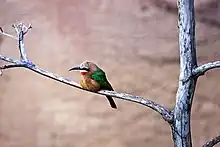White-fronted bee-eater
The white-fronted bee-eater (Merops bullockoides) is a species of bee-eater widely distributed in sub-equatorial Africa.
| White-fronted bee-eater | |
|---|---|
_Namibia.jpg.webp) | |
| In Namibia | |
| Scientific classification | |
| Domain: | Eukaryota |
| Kingdom: | Animalia |
| Phylum: | Chordata |
| Clade: | Dinosauria |
| Class: | Aves |
| Order: | Coraciiformes |
| Family: | Meropidae |
| Genus: | Merops |
| Species: | M. bullockoides |
| Binomial name | |
| Merops bullockoides Smith, A, 1834 | |
The species has a distinctive white forehead, a square tail, and a bright red patch on its throat. It nests in small colonies, digging holes in cliffs or earthen banks, and can usually be seen in low trees, waiting to hunt passing insects by making quick hawking flights or gliding down before hovering briefly to catch the prey.
Description
This species, like other bee-eaters, is a richly coloured, slender bird, but with a distinctive black mask, white forehead, square tail and a bright red throat. The size is 23 cm (9 in.). The upperparts are green, with cinnamon underparts. The call is a deep squeak.[2]

 White-fronted bee-eaters in a U.S. zoo
White-fronted bee-eaters in a U.S. zoo
Distribution
White-fronted bee-eaters are found in the vast savannah regions of sub-equatorial Africa. The habitat commonly consists of open country, often near gullies, where bees, their prey, live.
Behaviour
Nesting and reproduction

White-fronted bee-eaters nest in colonies averaging 200 individuals, digging, roosting, and nesting holes in cliffs or banks of earth. A population of bee-eaters may range across many square kilometres of savannah, but will come to the same colony to roost, socialize, and to breed. White-fronted bee-eaters have one of the most complex family-based social systems found in birds.
Colonies comprise socially monogamous, extended family groups with overlapping generations, known as "clans", which exhibit cooperative breeding. Non-breeding individuals become helpers to relatives and assist to raise their brood. In white-fronted bee-eaters, this helping behavior is particularly well developed, with helpers assisting in half of all nesting attempts.[3] These helpers may contribute to all aspects of the reproductive attempt, from digging the roosting or nesting chamber, to allofeeding the female, incubating and feeding the young; and have a large effect on increasing the number of young produced.[4]
Only 50% of non-breeders in a colony typically become helpers, and whether or not an individual becomes a helper and to whom it provides aid is heavily dependent on the degree of kinship involved. Non-breeders are most likely to become helpers when breeding pairs are genetically close relatives. When faced with a choice of potential recipient nests, helpers preferentially help the breeding pair to whom they are most closely related, suggesting that this behaviour may serve to increase the helper's inclusive fitness.
Female white-fronted bee-eaters leaving their nesting burrows must avoid pursuit by unmated males who may force them to the ground and rape them. Furthermore, their unwelcome attentions are preferentially against females who are laying eggs and who thus might lay the eggs of their rapist rather than their mate.[5]
Feeding and diet

Their diet is made up primarily of bees, but they also take other flying insects depending on the season and availability of prey. Two hunting methods have been observed. They either make quick hawking flights from lower branches of shrubs and trees, or glide slowly down from their perch and hover briefly to catch insects.
References
- BirdLife International (2016). "Merops bullockoides". IUCN Red List of Threatened Species. 2016: e.T22683684A92995705. doi:10.2305/IUCN.UK.2016-3.RLTS.T22683684A92995705.en. Retrieved 13 November 2021.
- Gosler, Andrew, ed. (1991), The Hamlyn photographic guide to birds of the world, foreword by Christopher Perrins, London: Hamlyn, ISBN 0-600-57239-0.
- Emlen, S. T. & Wrege, P. H. (1988), "The role of kinship in helping decisions among white-fronted bee-eaters", Behavioral Ecology and Sociobiology, 23 (5): 305–315, doi:10.1007/BF00300577, S2CID 33323731.
- Emlen, S. T. (1997), "Family Dynamics of Social Vertebrates", in Krebs, J. R.; Davies, N. B. (eds.), Behavioural Ecology: An evolutionary approach (4th ed.), Cambridge: Blackwell Science, ISBN 0-86542-731-3.
- Emlen, S. T. & Wrege, P. H. (1986), "Forced copulations and intraspecific parasitism: two costs of social living in the white-fronted bee-eater", Ethology, 71 (1): 2–29, doi:10.1111/j.1439-0310.1986.tb00566.x.
